Effects of Mesoscale Eddies in the Northern South China Sea on Phytoplankton Size and Physiological Status
Abstract
:1. Introduction
2. Data and Method
2.1. Satellite and Model Data
2.2. Calculations and Methods
3. Results
3.1. The Validation of PSC Satellite Data in the SCS
3.2. Distribution and Characteristics of Mesoscale Eddies in the Northern South China Sea
3.3. Monopole Distribution of Phytoplankton Size and Physiological Characteristics inside Mesoscale Eddies
3.4. 3-Dimensional Vertical Transport Based on HYCOM
3.5. Temporal Variations in Phytoplankton Size and Physiological Status Extracted from the Eddy-Interior Monopole Results
4. Discussion
5. Conclusions
Author Contributions
Funding
Institutional Review Board Statement
Informed Consent Statement
Data Availability Statement
Acknowledgments
Conflicts of Interest
References
- McGillicuddy, D.J.; Anderson, L.A.; Bates, N.R.; Bibby, T.; Buesseler, K.O.; Carlson, C.A.; Davis, C.S.; Ewart, C.; Falkowski, P.G.; Goldthwait, S.A.; et al. Eddy/wind interactions stimulate extraordinary mid-ocean plankton blooms. Science 2007, 316, 1021–1026. [Google Scholar] [CrossRef]
- Mahadevan, A.; Thomas, L.N.; Tandon, A. Comment on “eddy/wind interactions stimulate extraordinary mid-ocean plankton blooms”. Science 2008, 320, 448. [Google Scholar] [CrossRef] [Green Version]
- McGillicuddy, D.J. Mechanisms of Physical-Biological-Biogeochemical Interaction at the Oceanic Mesoscale. Annu. Rev. Mar. Sci. 2016, 8, 125–159. [Google Scholar] [CrossRef] [Green Version]
- Siegel, D.A.; Peterson, P.; McGillicuddy, D.J.; Maritorena, S.; Nelson, N.B. Bio-optical footprints created by mesoscale eddies in the Sargasso Sea. Geophys. Res. Lett. 2011, 38, L13608. [Google Scholar] [CrossRef] [Green Version]
- Martin, A.P.; Pondaven, P. On estimates for the vertical nitrate flux due to eddy pumping. J. Geophys. Res.-Oceans 2003, 108, 3359. [Google Scholar] [CrossRef]
- Siegel, D.A.; McGillicuddy, D.J.; Fields, E.A. Mesoscale eddies, satellite altimetry, and new production in the Sargasso Sea. J. Geophys. Res.-Oceans 1999, 104, 13359–13379. [Google Scholar] [CrossRef] [Green Version]
- Gaube, P.; Chelton, D.B.; Samelson, R.M.; Schlax, M.G.; O’Neill, L.W. Satellite Observations of Mesoscale Eddy-Induced Ekman Pumping. J. Phys. Oceanogr. 2015, 45, 104–132. [Google Scholar] [CrossRef] [Green Version]
- Martin, A.P.; Richards, K.J.; Law, C.S.; Liddicoat, M. Horizontal dispersion within an anticyclonic mesoscale eddy. Deep-Sea Res. Part II 2001, 48, 739–755. [Google Scholar] [CrossRef]
- Eden, C.; Dietze, H. Effects of mesoscale eddy/wind interactions on biological new production and eddy kinetic energy. J. Geophys. Res.-Oceans 2009, 114, C05023. [Google Scholar] [CrossRef] [Green Version]
- Kahru, M.; Fiedler, P.C.; Gille, S.T.; Manzano, M.; Mitchell, B.G. Sea level anomalies control phytoplankton biomass in the Costa Rica Dome area. Geophys. Res. Lett. 2007, 34, L22601. [Google Scholar] [CrossRef]
- Kahru, M.; Mitchell, B.G.; Gille, S.T.; Hewes, C.D.; Holm-Hansen, O. Eddies enhance biological production in the Weddell-Scotia confluence of the southern ocean. Geophys. Res. Lett. 2007, 34, L14603. [Google Scholar] [CrossRef] [Green Version]
- Liu, F.F.; Tang, S.L.; Huang, R.X.; Yin, K.D. The asymmetric distribution of phytoplankton in anticyclonic eddies in the western South China Sea. Deep-Sea Res. Part I 2017, 120, 29–38. [Google Scholar] [CrossRef]
- Mahadevan, A. The Impact of Submesoscale Physics on Primary Productivity of Plankton. Annu. Rev. Mar. Sci. 2016, 8, 161–184. [Google Scholar] [CrossRef] [Green Version]
- Mizobata, K.; Saitoh, S.I.; Shiomoto, A.; Miyamura, T.; Shiga, N.; Imai, K.; Toratani, M.; Kajiwara, Y.; Sasaoka, K. Bering Sea cyclonic and anticyclonic eddies observed during summer 2000 and 2001. Prog. Oceanogr. 2002, 55, 65–75. [Google Scholar] [CrossRef]
- Liu, F.F.; Tang, S.L.; Chen, C.Q. Impact of nonlinear mesoscale eddy on phytoplankton distribution in the northern South China Sea. J. Mar. Syst. 2013, 123, 33–40. [Google Scholar] [CrossRef]
- Ning, X.; Chai, F.; Xue, H.; Cai, Y.; Liu, C.; Shi, J. Physical-biological oceanographic coupling influencing phytoplankton and primary production in the South China Sea. J. Geophys. Res.-Oceans 2004, 109, C10005. [Google Scholar] [CrossRef] [Green Version]
- Xiu, P.; Chai, F.; Shi, L.; Xue, H.J.; Chao, Y. A census of eddy activities in the South China Sea during 1993–2007. J. Geophys. Res.-Oceans 2010, 115, C03012. [Google Scholar] [CrossRef] [Green Version]
- Li, Q.Y.; Sun, L.; Liu, S.S.; Xian, T.; Yan, Y.F. A new mononuclear eddy identification method with simple splitting strategies. Remote Sens. Lett. 2014, 5, 65–72. [Google Scholar] [CrossRef]
- Lin, I.I.; Lien, C.C.; Wu, C.R.; Wong, G.T.F.; Huang, C.W.; Chiang, T.L. Enhanced primary production in the oligotrophic South China Sea by eddy injection in spring. Geophys. Res. Lett. 2010, 37, L16602. [Google Scholar] [CrossRef] [Green Version]
- Treguer, P.; Bowler, C.; Moriceau, B.; Dutkiewicz, S.; Gehlen, M.; Aumont, O.; Bittner, L.; Dugdale, R.; Finkel, Z.; Iudicone, D.; et al. Influence of diatom diversity on the ocean biological carbon pump. Nat. Geosci. 2018, 11, 27–37. [Google Scholar] [CrossRef]
- Chen, Y.L.L.; Chen, H.Y.; Lin, I.I.; Lee, M.A.; Chang, J. Effects of cold eddy on Phytoplankton production and assemblages in Luzon Strait bordering the South China Sea. J. Oceanogr. 2007, 63, 671–683. [Google Scholar] [CrossRef]
- Ellwood, M.J.; Strzepek, R.F.; Strutton, P.G.; Trull, T.W.; Fourquez, M.; Boyd, P.W. Distinct iron cycling in a Southern Ocean eddy. Nat. Commun. 2020, 11, 825. [Google Scholar] [CrossRef] [Green Version]
- Frenger, I.; Munnich, M.; Gruber, N.; Knutti, R. Southern Ocean eddy phenomenology. J. Geophys. Res.-Oceans 2015, 120, 7413–7449. [Google Scholar] [CrossRef] [Green Version]
- McGillicuddy, D.J., Jr.; Robinson, A.R.; Siegel, D.A.; Jannasch, H.W.; Johnson, R.; Dickey, T.D.; McNeil, J.; Michaels, A.F.; Knap, A.H. Influence of mesoscale eddies on new production in the Sargasso Sea. Nature 1998, 394, 263–266. [Google Scholar] [CrossRef]
- Barcelo-Llull, B.; Mason, E.; Capet, A.; Pascual, A. Impact of vertical and horizontal advection on nutrient distribution in the southeast Pacific. Ocean Sci. 2016, 12, 1003–1011. [Google Scholar] [CrossRef] [Green Version]
- Xi, H.; Losa, S.N.; Mangin, A.; Garnesson, P.; Bretagnon, M.; Demaria, J.; Soppa, M.A.; D’Andon, O.H.F.; Bracher, A. Global Chlorophyll a Concentrations of Phytoplankton Functional Types With Detailed Uncertainty Assessment Using Multisensor Ocean Color and Sea Surface Temperature Satellite Products. J. Geophys. Res.-Oceans 2021, 126, e2020JC017127. [Google Scholar] [CrossRef]
- Maritorena, S.; d’Andon, O.H.F.; Mangin, A.; Siegel, D.A. Merged satellite ocean color data products using a bio-optical model: Characteristics, benefits and issues. Remote Sens. Environ. 2010, 114, 1791–1804. [Google Scholar] [CrossRef]
- Stramski, D.; Reynolds, R.A.; Babin, M.; Kaczmarek, S.; Lewis, M.R.; Rottgers, R.; Sciandra, A.; Stramska, M.; Twardowski, M.S.; Franz, B.A.; et al. Relationships between the surface concentration of particulate organic carbon and optical properties in the eastern South Pacific and eastern Atlantic Oceans. Biogeosciences 2008, 5, 171–201. [Google Scholar] [CrossRef] [Green Version]
- Behrenfeld, M.J.; Falkowski, P.G. A consumer’s guide to phytoplankton primary productivity models. Limnol. Oceanogr. 1997, 42, 1479–1491. [Google Scholar] [CrossRef] [Green Version]
- Yoshie, N.; Suzuki, K.; Kuwata, A.; Nishioka, J.; Saito, H. Temporal and spatial variations in photosynthetic physiology of diatoms during the spring bloom in the western subarctic Pacific. Mar. Ecol. Prog. Ser. 2010, 399, 39–52. [Google Scholar] [CrossRef]
- Bleck, R. An oceanic general circulation model framed in hybrid isopycnic-Cartesian coordinates. Ocean Model. 2002, 4, 55–88. [Google Scholar] [CrossRef]
- Halliwell, G.R. Evaluation of vertical coordinate and vertical mixing algorithms in the HYbrid-Coordinate Ocean Model (HYCOM). Ocean Model. 2004, 7, 285–322. [Google Scholar] [CrossRef]
- Vidussi, F.; Claustre, H.; Manca, B.B.; Luchetta, A.; Marty, J.C. Phytoplankton pigment distribution in relation to upper thermocline circulation in the eastern Mediterranean Sea during winter. J. Geophys. Res.-Oceans 2001, 106, 19939–19956. [Google Scholar] [CrossRef]
- Uitz, J.; Claustre, H.; Morel, A.; Hooker, S.B. Vertical distribution of phytoplankton communities in open ocean: An assessment based on surface chlorophyll. J. Geophys. Res.-Oceans 2006, 111, C08005. [Google Scholar] [CrossRef]
- Gieskes, W.W.C.; Kraay, G.W.; Nontji, A.; Setiapermana, D.; Sutomo. Monsoonal alternation of a mixed and a layered structure in the phytoplankton of the euphotic zone of the banda sea (Indonesia): A mathematical analysis of algal pigment fingerprints. Neth. J. Sea Res. 1988, 22, 123–137. [Google Scholar] [CrossRef]
- Chelton, D.B.; Schlax, M.G.; Samelson, R.M. Global observations of nonlinear mesoscale eddies. Prog. Oceanogr. 2011, 91, 167–216. [Google Scholar] [CrossRef]
- Schutte, F.; Brandt, P.; Karstensen, J. Occurrence and characteristics of mesoscale eddies in the tropical northeastern Atlantic Ocean. Ocean Sci. 2016, 12, 663–685. [Google Scholar] [CrossRef] [Green Version]
- Ho, C.R.; Kuo, N.J.; Zheng, Q.N.; Soong, Y.S. Dynamically active areas in the South China Sea detected from TOPEX/POSEIDON satellite altimeter data. Remote Sens. Environ. 2000, 71, 320–328. [Google Scholar] [CrossRef]
- Wang, D.X.; Xu, H.Z.; Lin, J.; Hu, J.Y. Anticyclonic Eddies in the Northeastern South China Sea during Winter 2003/2004. J. Oceanogr. 2008, 64, 925–935. [Google Scholar] [CrossRef]
- Wang, G.H.; Chen, D.; Su, J.L. Winter eddy genesis in the eastern south china sea due to orographic wind jets. J. Phys. Oceanogr. 2008, 38, 726–732. [Google Scholar] [CrossRef]
- DuRand, M.D.; Olson, R.J.; Chisholm, S.W. Phytoplankton population dynamics at the Bermuda Atlantic Time-series station in the Sargasso Sea. Deep-Sea Res. Part II 2001, 48, 1983–2003. [Google Scholar] [CrossRef]
- Lindell, D.; Post, A.F. Ultraphytoplankton succession is triggered by deep winter mixing in the gulf of Aqaba (Eilat), Red Sea. Limnol. Oceanogr. 1995, 40, 1130–1141. [Google Scholar] [CrossRef]
- Chen, Y.L.L. Comparisons of primary productivity and phytoplankton size structure in the marginal regions of southern East China Sea. Cont. Shelf Res. 2000, 20, 437–458. [Google Scholar] [CrossRef]
- Sathyendranath, S.; Cota, G.; Stuart, V.; Maass, H.; Platt, T. Remote sensing of phytoplankton pigments: A comparison of empirical and theoretical approaches. Int. J. Remote Sens. 2001, 22, 249–273. [Google Scholar] [CrossRef]
- Ciotti, A.M.; Lewis, M.R.; Cullen, J.J. Assessment of the relationships between dominant cell size in natural phytoplankton communities and the spectral shape of the absorption coefficient. Limnol. Oceanogr. 2002, 47, 404–417. [Google Scholar] [CrossRef] [Green Version]
- Kostadinov, T.S.; Siegel, D.A.; Maritorena, S. Retrieval of the particle size distribution from satellite ocean color observations. J. Geophys. Res.-Oceans 2009, 114, C09015. [Google Scholar] [CrossRef]
- Raimbault, P.; Taupier-Letage, I.; Rodier, M. Vertical Size Distribution of Phytoplankton in the Western Mediterranean Sea during Early Summer. Mar. Ecol. Prog. Ser. 1988, 45, 153–158. [Google Scholar] [CrossRef]
- Yentsch, C.S.; Phinney, D.A. A bridge between ocean optics and microbial ecology. Limnol. Oceanogr. 1989, 34, 1694–1705. [Google Scholar] [CrossRef]
- Li, D.; Yang, S.; Wei, Y.; Wang, X.; Mao, Y.; Guo, C.; Sun, J. Response of Size-Fractionated Chlorophyll a to Upwelling and Kuroshio in Northeastern South China Sea. J. Mar. Sci. Eng. 2022, 10, 784. [Google Scholar] [CrossRef]
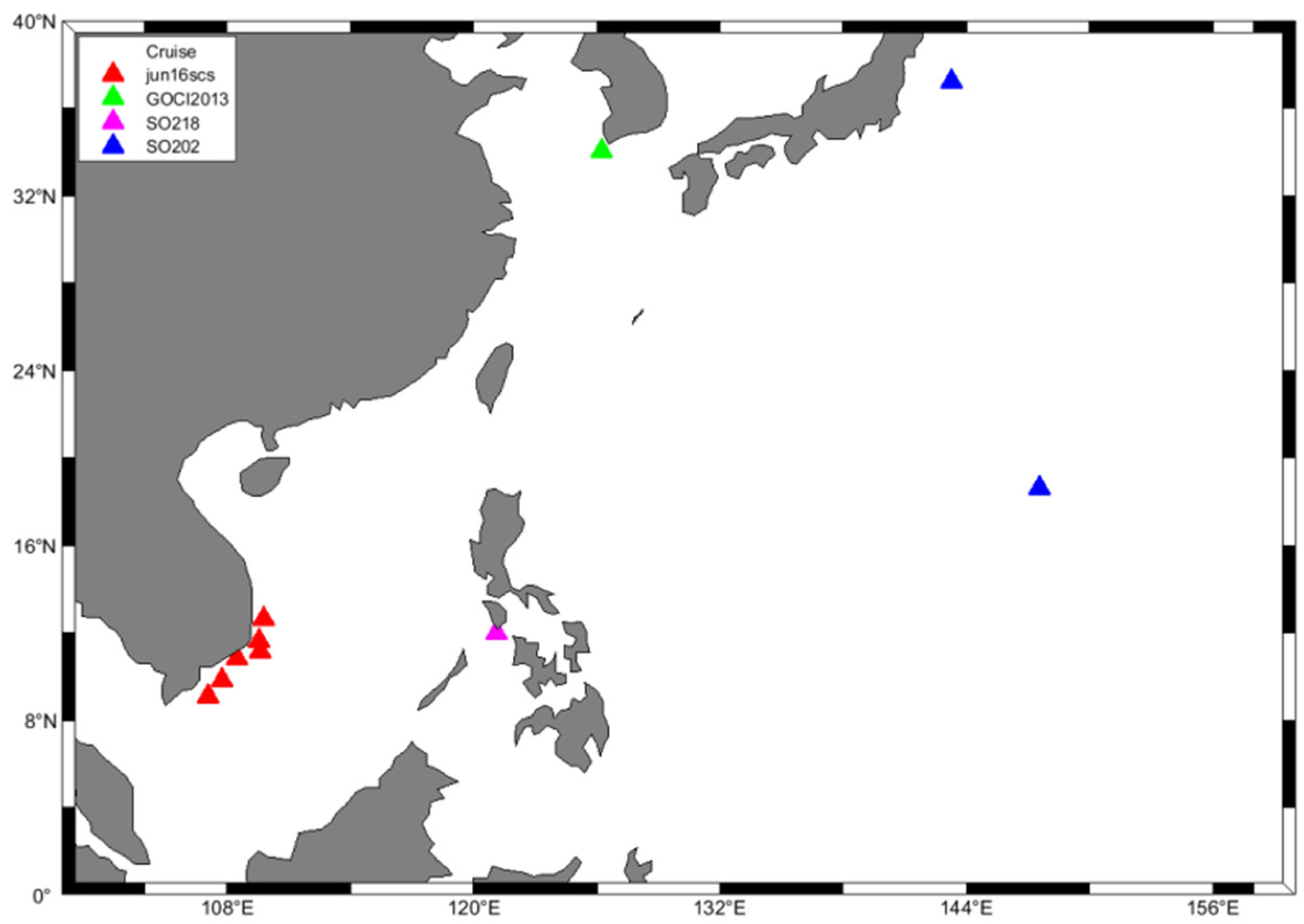
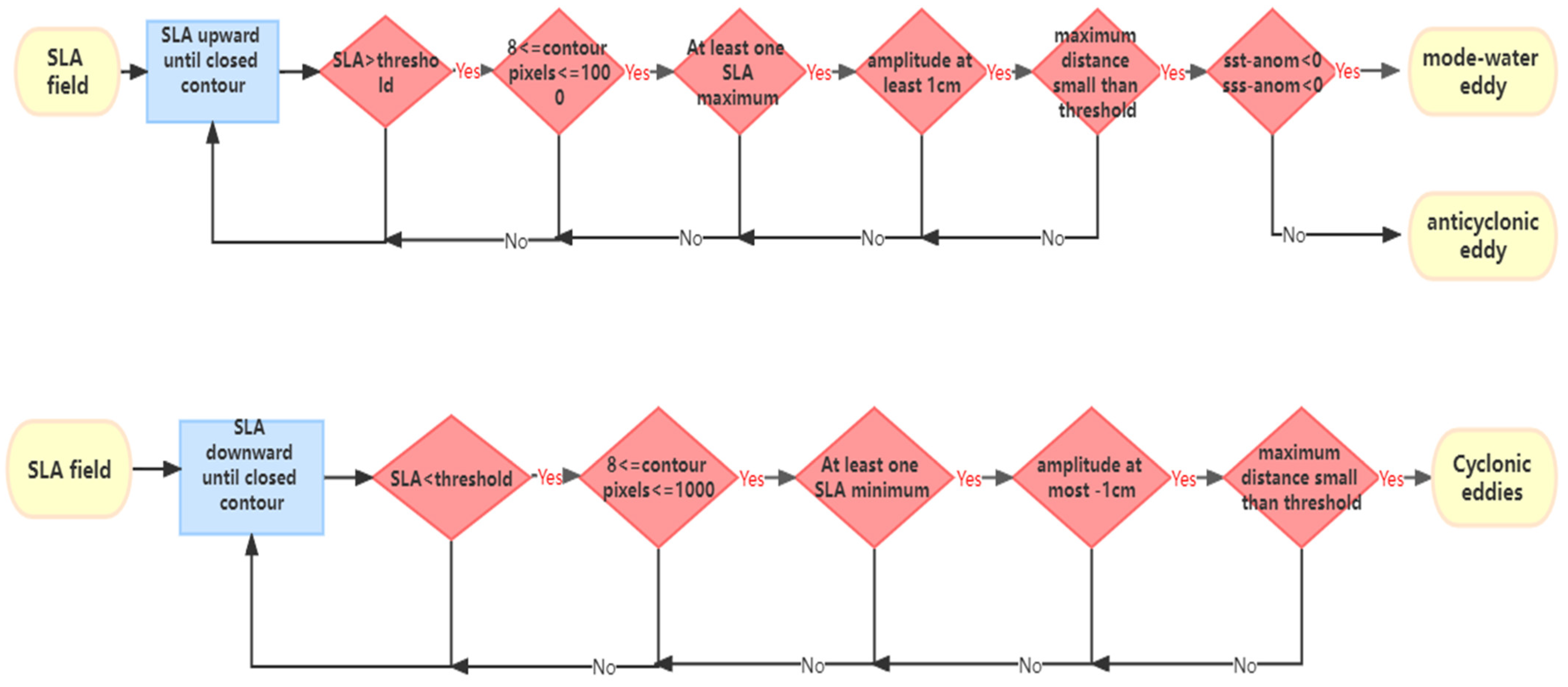
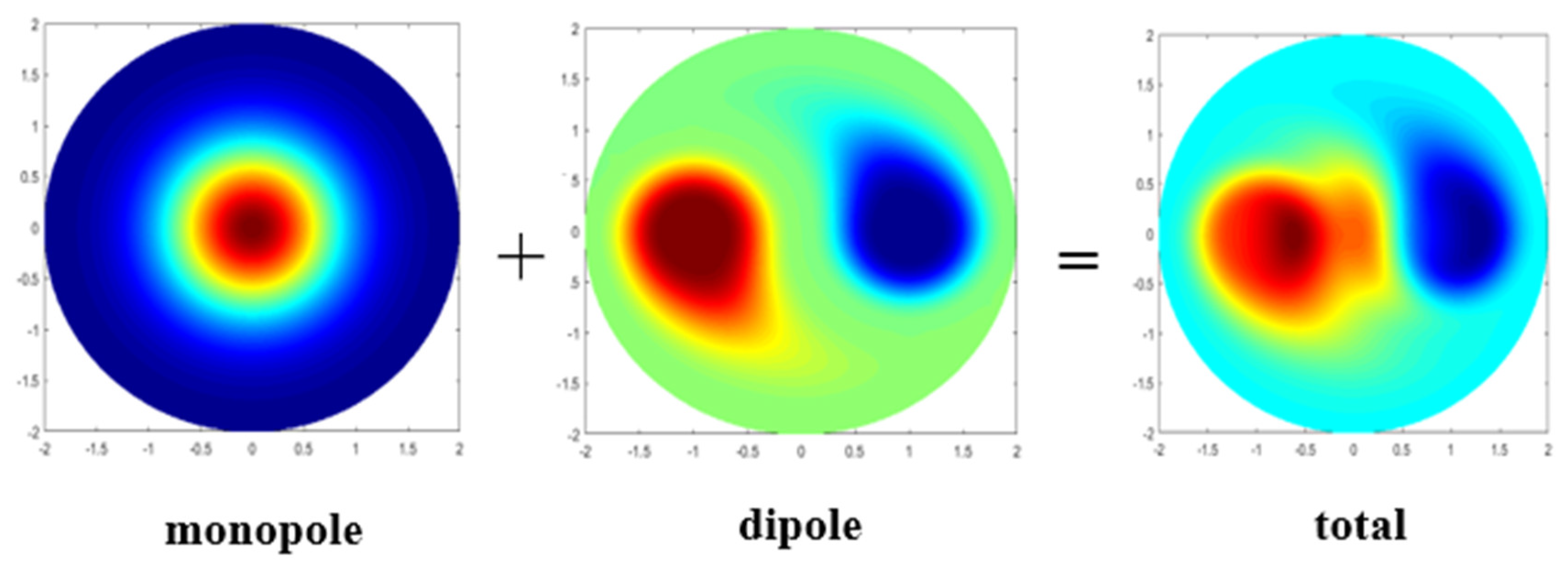

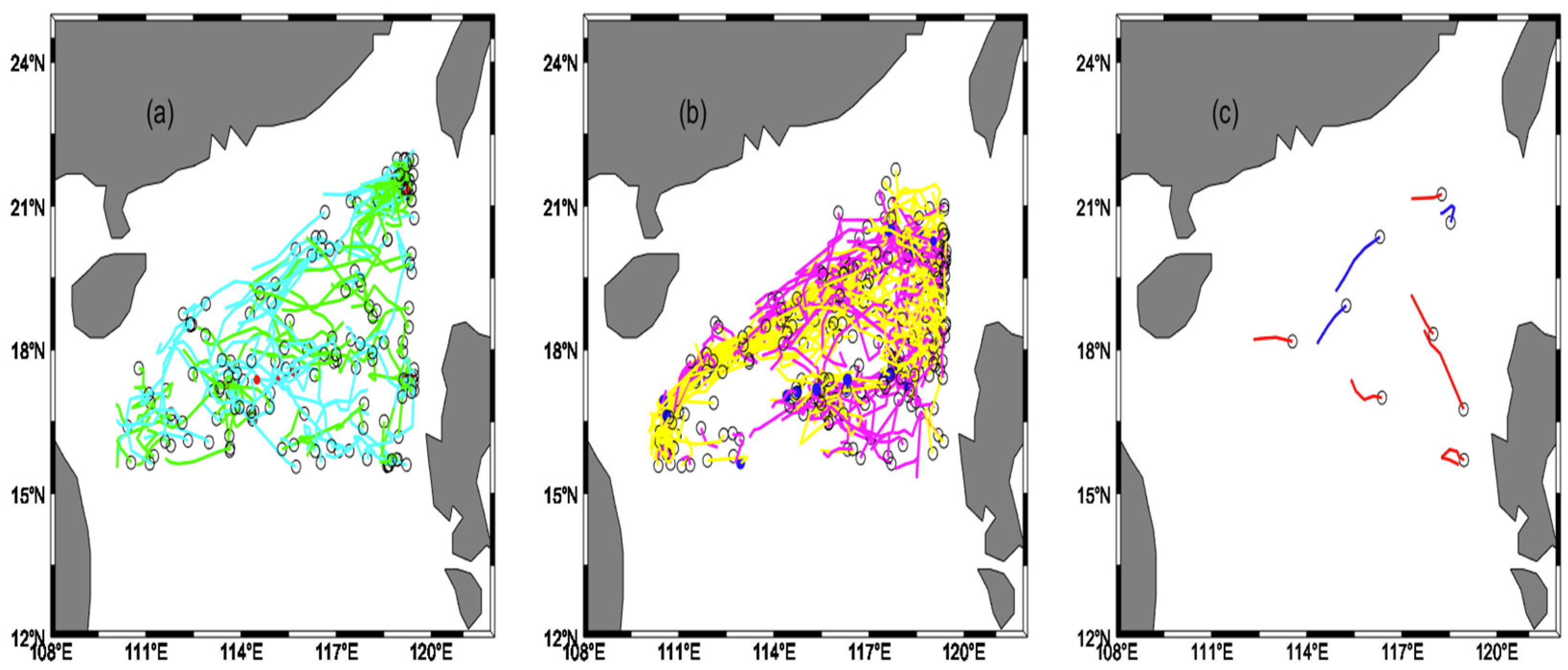

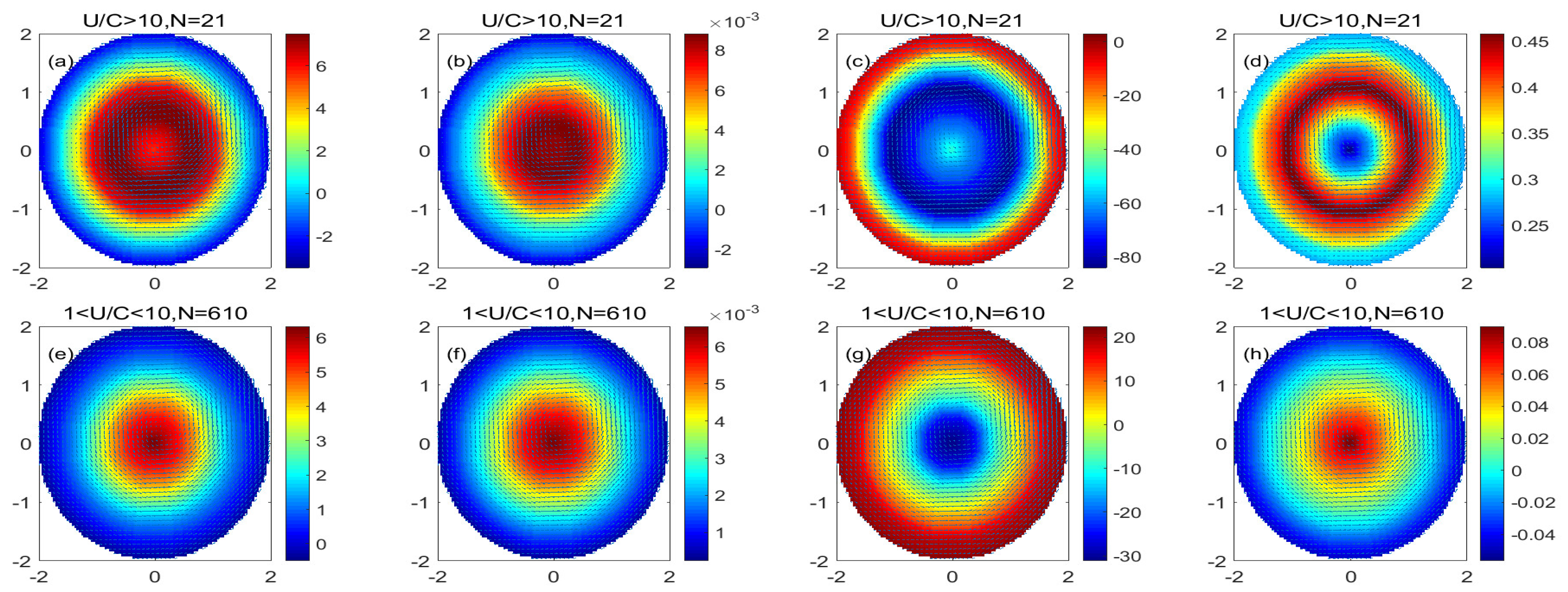


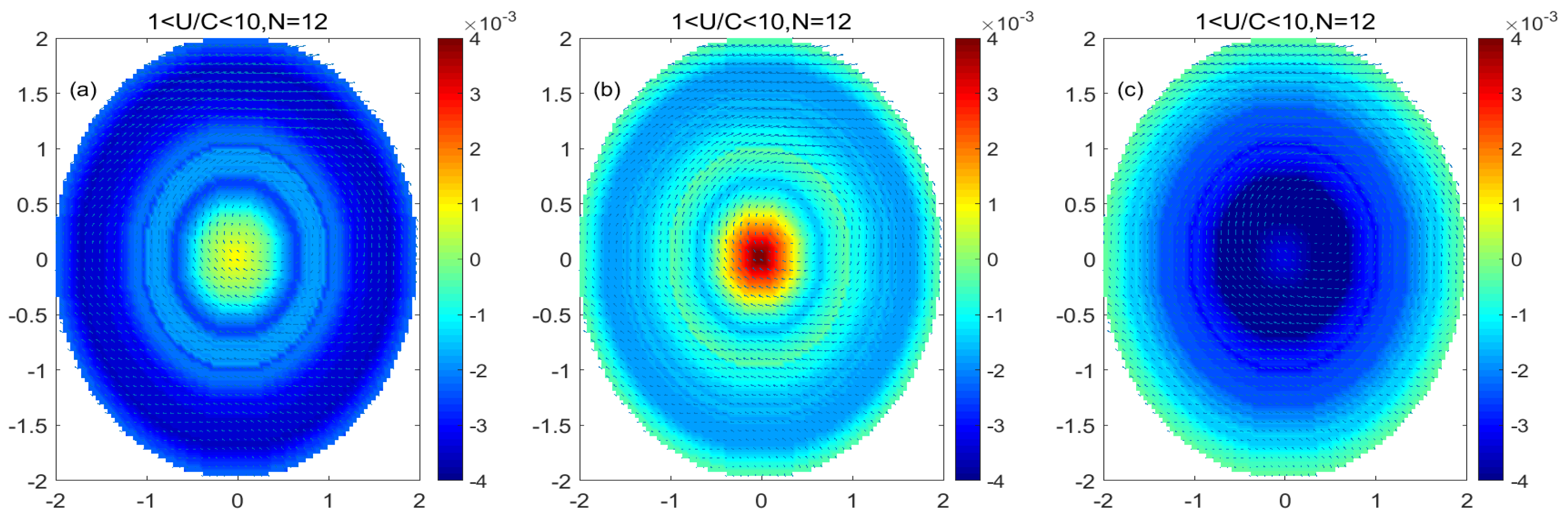



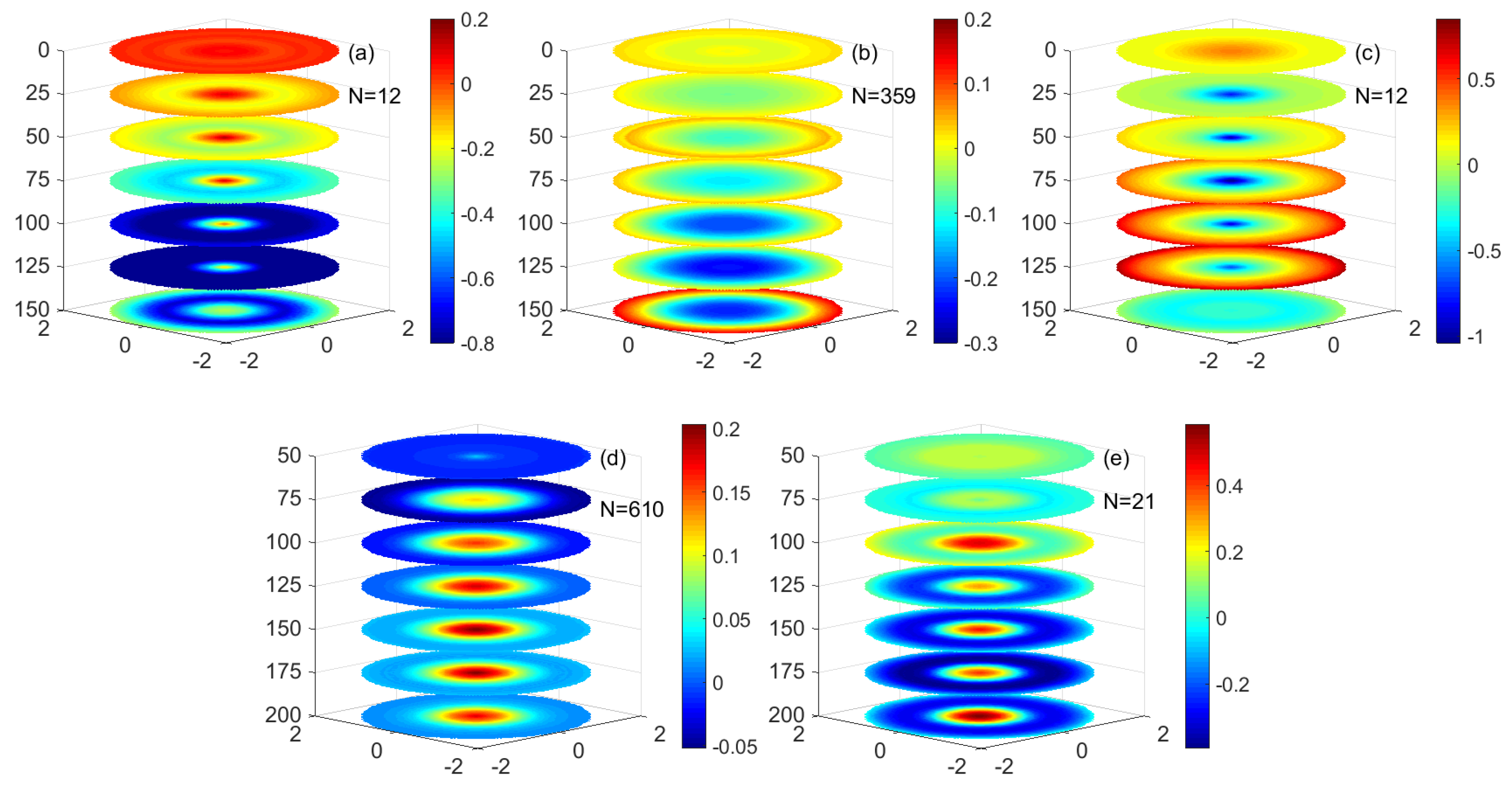
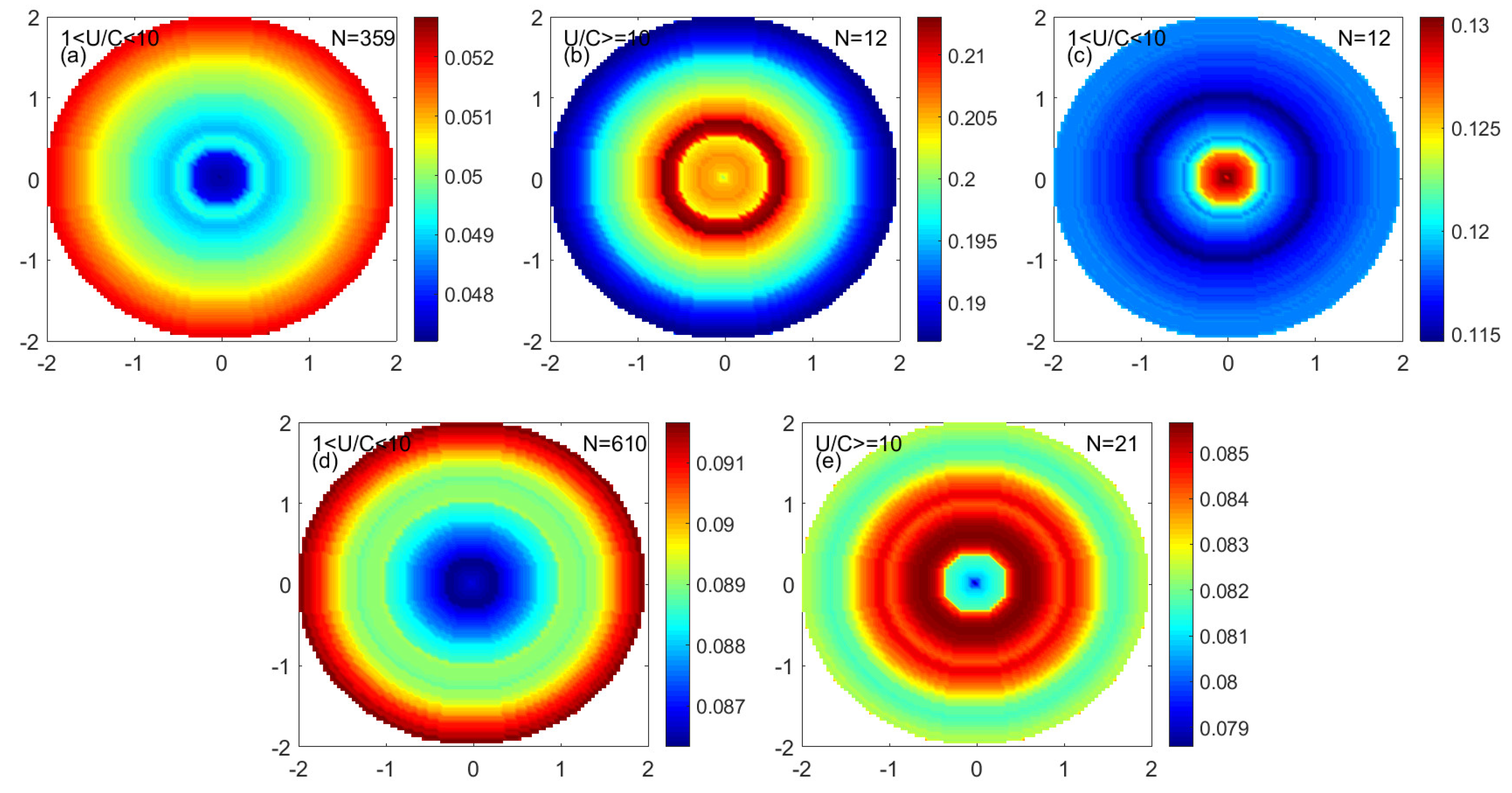
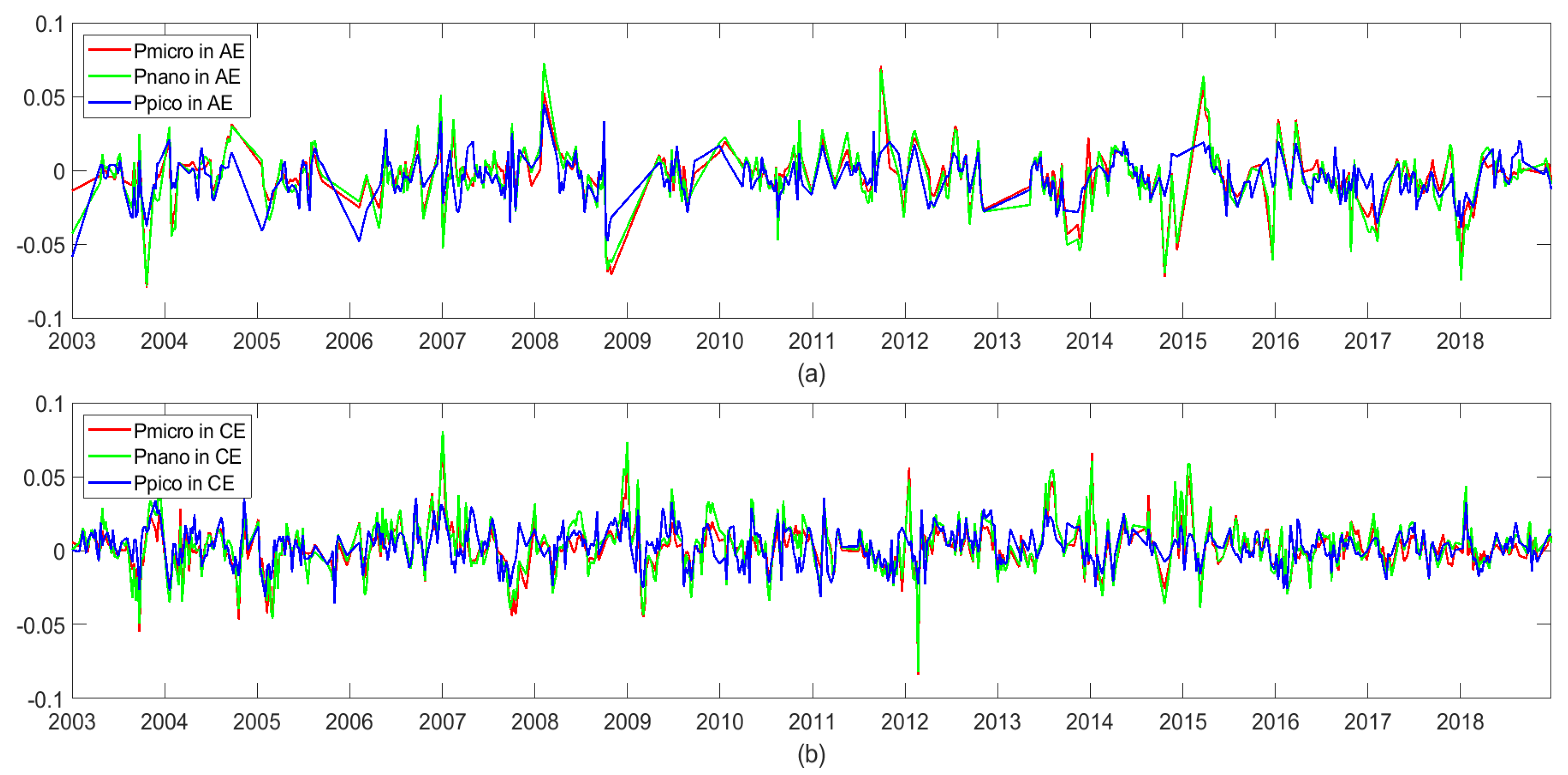
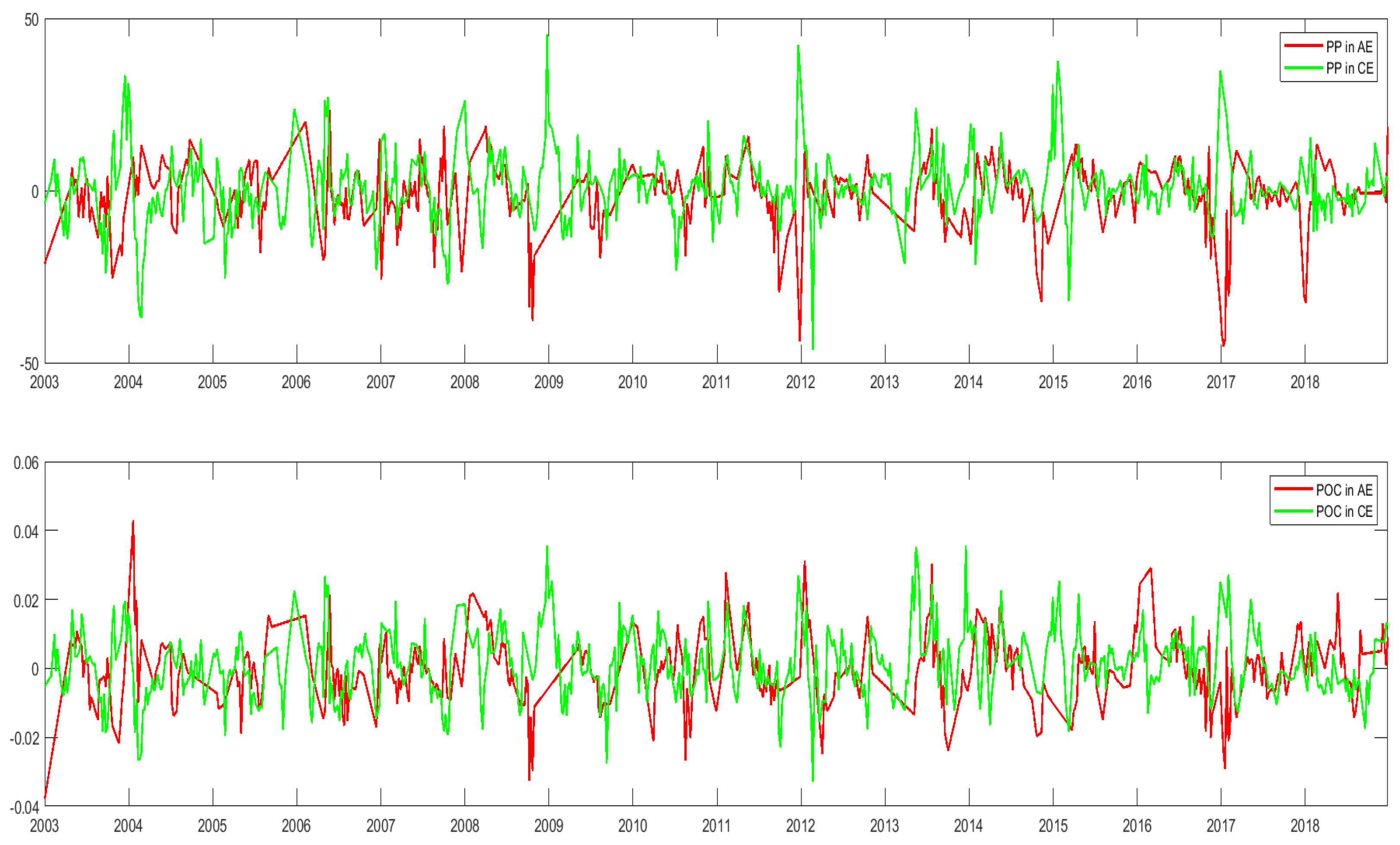
| Statistical Data | Cyclonic | Anticyclonic | Mode-Water | ||||||
|---|---|---|---|---|---|---|---|---|---|
| Eddy’s Number | S. | W. | All | S | W. | All | S. | W. | All |
| 420 | 1040 | 1460 | 361 | 635 | 996 | 5 | 22 | 27 | |
| Nonlinear Number | Low | High | all | Low | High | All | Low | High | All |
| 610 | 21 | 631 | 359 | 12 | 371 | 12 | 0 | 12 | |
| A(cm) | 13.02 | 14.07 | 13.09 | ||||||
| U(m/s) | 0.138 | 0.149 | 0.159 | ||||||
| r(km) | 112.67 | 111.58 | 106.3986 | ||||||
| c(m/s) | 0.064 | 0.058 | 0.053 | ||||||
| Trajectories | S. | W. | All | S. | W. | All | S. | W. | All |
| 118 | 133 | 251 | 94 | 83 | 177 | 6 | 3 | 9 | |
| The ratio of nonlinear eddies in all eddies (%) | 31.32 | 31.28 | 27.91 | ||||||
| Average of nonlinearity | 2.77 | 2.90 | 1.49 | ||||||
Disclaimer/Publisher’s Note: The statements, opinions and data contained in all publications are solely those of the individual author(s) and contributor(s) and not of MDPI and/or the editor(s). MDPI and/or the editor(s) disclaim responsibility for any injury to people or property resulting from any ideas, methods, instructions or products referred to in the content. |
© 2022 by the authors. Licensee MDPI, Basel, Switzerland. This article is an open access article distributed under the terms and conditions of the Creative Commons Attribution (CC BY) license (https://creativecommons.org/licenses/by/4.0/).
Share and Cite
Chen, J.; Liu, F. Effects of Mesoscale Eddies in the Northern South China Sea on Phytoplankton Size and Physiological Status. Remote Sens. 2023, 15, 245. https://doi.org/10.3390/rs15010245
Chen J, Liu F. Effects of Mesoscale Eddies in the Northern South China Sea on Phytoplankton Size and Physiological Status. Remote Sensing. 2023; 15(1):245. https://doi.org/10.3390/rs15010245
Chicago/Turabian StyleChen, Jinzheng, and Fenfen Liu. 2023. "Effects of Mesoscale Eddies in the Northern South China Sea on Phytoplankton Size and Physiological Status" Remote Sensing 15, no. 1: 245. https://doi.org/10.3390/rs15010245
APA StyleChen, J., & Liu, F. (2023). Effects of Mesoscale Eddies in the Northern South China Sea on Phytoplankton Size and Physiological Status. Remote Sensing, 15(1), 245. https://doi.org/10.3390/rs15010245





